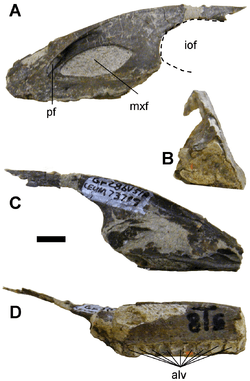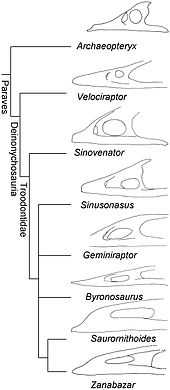Geminiraptor
| Geminiraptor Temporal range: Early Cretaceous, 130Ma | |
|---|---|
 | |
| The holotype maxilla in multiple views | |
| Scientific classification | |
| Kingdom: | Animalia |
| Phylum: | Chordata |
| Clade: | Dinosauria |
| Suborder: | Theropoda |
| Superfamily: | †Troodontoidea |
| Family: | †Troodontidae |
| Genus: | †Geminiraptor Senter et al., 2010 |
| Species: | † G. suarezarum |
| Binomial name | |
| Geminiraptor suarezarum Senter et al., 2010 | |

Comparison of the maxilla of Geminiraptor to those of other paravians
Geminiraptor is a genus of troodontid dinosaur. Geminiraptor lived during the lower Cretaceous period (?lower Barremian age) in what is now Utah, USA. It is known from CEUM 7319, a maxilla recovered from the lower Yellow Cat Member of the Cedar Mountain Formation, dating to at least the early Barremian stage (about 130 million years ago). Geminiraptor was named by Phil Senter, James I. Kirkland, John Bird and Jeff A. Bartlett in 2010. The type species of Geminiraptor is G. suarezarum. The specific name refers to Drs. Celina and Marina Suarez, the twin geologists who discovered the Suarez site. The generic name is from the Latin geminae (“twins,” in honor of the Suarez sisters) and raptor ("seizer").[1]
References
- ↑ Phil Senter, James I. Kirkland, John Bird, Jeff A. Bartlett (2010). "A New Troodontid Theropod Dinosaur from the Lower Cretaceous of Utah". PLoS ONE 5 (12): e14329. doi:10.1371/journal.pone.0014329. PMC 3002269. PMID 21179513.